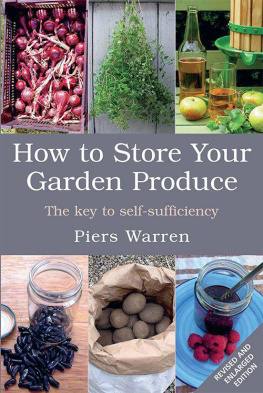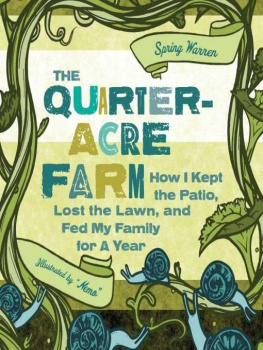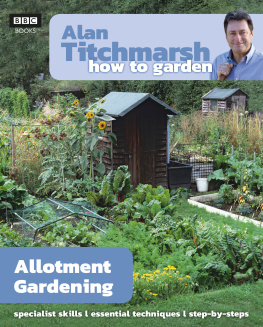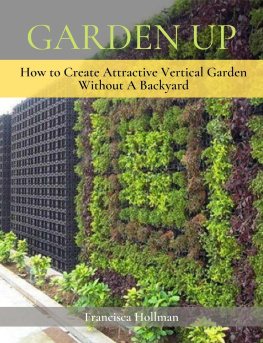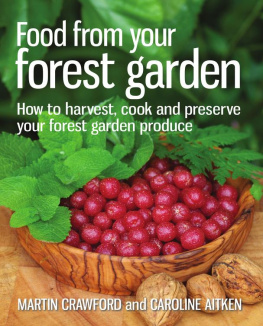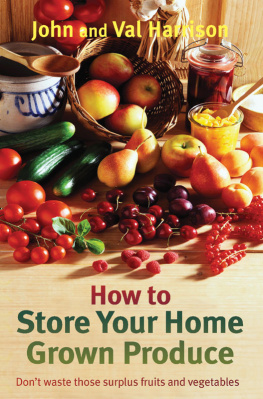Warren - How to Store Your Garden Produce
Here you can read online Warren - How to Store Your Garden Produce full text of the book (entire story) in english for free. Download pdf and epub, get meaning, cover and reviews about this ebook. year: 2010, publisher: Green Books, genre: Home and family. Description of the work, (preface) as well as reviews are available. Best literature library LitArk.com created for fans of good reading and offers a wide selection of genres:
Romance novel
Science fiction
Adventure
Detective
Science
History
Home and family
Prose
Art
Politics
Computer
Non-fiction
Religion
Business
Children
Humor
Choose a favorite category and find really read worthwhile books. Enjoy immersion in the world of imagination, feel the emotions of the characters or learn something new for yourself, make an fascinating discovery.
- Book:How to Store Your Garden Produce
- Author:
- Publisher:Green Books
- Genre:
- Year:2010
- Rating:4 / 5
- Favourites:Add to favourites
- Your mark:
- 80
- 1
- 2
- 3
- 4
- 5
How to Store Your Garden Produce: summary, description and annotation
We offer to read an annotation, description, summary or preface (depends on what the author of the book "How to Store Your Garden Produce" wrote himself). If you haven't found the necessary information about the book — write in the comments, we will try to find it.
How to Store Your Garden Produce — read online for free the complete book (whole text) full work
Below is the text of the book, divided by pages. System saving the place of the last page read, allows you to conveniently read the book "How to Store Your Garden Produce" online for free, without having to search again every time where you left off. Put a bookmark, and you can go to the page where you finished reading at any time.
Font size:
Interval:
Bookmark:
HOW TO STORE YOUR
GARDEN PRODUCE
How to Store Your
Garden Produce
The key to self-sufficiency
Piers Warren

Revised and enlarged edition
with illustrations by Tessa Pettingell

This revised and enlarged edition
first published in 2008
by Green Books Ltd
Foxhole, Dartington
Totnes, Devon TQ9 6EB
Reprinted 2008, 2009 (with amendments
to some recipes), 2010
First published in ebook formats 2010
Text Piers Warren 2006-2010
Illustrations Tessa Pettingell 2006-2010
Piers Warren has asserted his moral right to be identified
as the author of this work.
All rights reserved. No part of this book may be transmitted
or reproduced in any form by any means without
permission in writing from the publisher.
Print format ISBN 978 1 900322 17 1
PDF format ISBN 978 1 907448 00 3
ePub format ISBN 978 1 907448 01 0
eBook ISBN 978 1 907448 00 3
Contents
Introduction

Why is storing your garden produce
the key to self-sufficiency?
Because with less than an acre of garden you can grow enough produce to feed a family of four for a year, but since much of the produce will become ready at the same time in the summer and autumn most of it will go to waste without proper storage, and youll be off to the supermarket again.
Ive always been obsessed with the idea of self-sufficiency, and have always hated waste, so as a keen vegetable grower it was only natural that I explored the overlooked art of storage. To some extent it is a lost art. These days you can go to the supermarket any day of the week and buy produce from many different countries. Imagine being told that the lettuces were all sold out try again in six months! In the past, effective storage was a matter of life and death: if your potatoes rotted, your family would go hungry possibly starve.
I have also always felt ridiculous buying vegetables or fruit that have been flown halfway round the world when I had been growing a surplus of the same ones myself only a few months earlier.
Plus there are so many other benefits from eating your own produce year round:
1. A huge sense of satisfaction of self-reliance that you alone can meet the most important need of your family.
2. Home-grown fruit and vegetables are far cheaper than shop-bought (if not free) and you will have healthy exercise growing them. Why pay expensive gym fees and work out in a sweaty windowless room when the Green Gym is right outside your own back door, or down on the allotment? It is also said that gardeners live longer because they are always looking forward to the next season of growing, harvesting and storing.
3. What are you eating? You have little chance of knowing what chemicals or genetic modification have been used on produce you buy from a shop. At least you know how your own fruit and veg have been raised and if youre an organic gardener like me (which I thoroughly recommend), youll know your produce couldnt be safer, for both you and the environment.
4. Eating food you have produced in your own garden is by far the most environmentally sound way of doing things: no unnecessary packaging, no transport pollution, no encouragement of vast monocrops and so on.
5. You can create your own by-products: storage may simply be a result of your desire to create a specific product or ingredient such as cider or dried mushrooms.
6. Pleasure! Some storage activities: stringing onions, making wine, concocting chutneys, are pleasurable in themselves and the end products are definitely for enjoyment.
Why do you need special methods in the first place?
When keeping fresh food for any length of time you have four main enemies: enzymes, bacteria, yeasts and fungi.
Enzymes are proteins naturally found in all fresh produce which control various processes; some of them help break down food as we digest it. They can work pretty quickly: for example, they are responsible for apples turning rapidly brown when cut. Enzymes can spoil food soon after harvesting, so our aim must be to halt their action as quickly as possible. Extreme heat stops the enzymes working permanently, as is the case in bottling. Extreme cold (18C / 1F or less) stops them working temporarily, as in freezing.
Bacteria are micro-organisms which can multiply rapidly. They are the main causes of food poisoning, either by producing toxins (e.g. causing botulism), or by being poisonous themselves. Contamination can come from anywhere: soil, hands, utensils, apparently clean jars etc., so the key is to halt or slow their growth. This can be done by killing them with extreme heat, or slowing their activity with cold, a high concentration of sugar or salt, or acid conditions as in pickling. ).
Yeasts are also microscopic, but are not dangerous like bacteria and of course they can be our allies when fermenting sugar to make cider, wine and beer. In terms of spoilage they are most often responsible for fermenting jams; and as yeasts are destroyed by heat, this means they contaminate the jam after potting. Their activity is slowed down by cold, which is why it is a good idea to keep opened jars of jam in the fridge.
Fungi produce minuscule spores that are in the air all around us, so any uncovered food will sooner or later be infected. As the fungal growth develops, the food will appear mouldy and will be unfit for consumption although rarely dangerous. Freezing, pickling etc. will stop fungal growth, but equally important are methods to stop spores reaching the food in the first place: burying harvested carrots in sand, for example.
Storage and preservation techniques fight these enemies mainly by using heat, cold or acid, by removing moisture, or simply by creating conditions where spoilage is less likely.
Note that although there are some methods such as drying and bottling that may render food safe to eat for many years, your aim should be to store food only until the next seasons fresh produce is available (perhaps an exception to this is some wines which can improve with age to a certain point). This ensures you are eating the highest quality stored food at all times. There is no point in eating tough old broad beans that have sat in the freezer for many months when you have pods bursting with succulent fresh beans in the garden. So, planning quantities and timing is essential for good storage.
So how can this book help you?
Part One looks at the various storage methods in general. Many of these are applicable to a range of produce. Start here to get a good background of the methods available. It is true that some of the methods would be more accurately defined as preservation rather than storage (making jam for example), but the idea is to have the full range of possibilities in front of you when deciding what to do with your mountain of raspberries.
Part Two is more of a reference section, which lists most plant produce grown commonly in gardens and allotments. For each one, the most appropriate methods are listed with specific advice. Your choice of method will depend on various factors, including quantity of produce to be stored, equipment and space available, family tastes, and personal preferences. You may have grown gherkins specifically for pickling, for example, or extra strawberries for jam-making.
Each section in Part Two also contains a list of recommended varieties. Where possible these have been chosen because they are varieties particularly suitable for storage; otherwise they are personal favourites or unusual varieties worth trying.
Next pageFont size:
Interval:
Bookmark:
Similar books «How to Store Your Garden Produce»
Look at similar books to How to Store Your Garden Produce. We have selected literature similar in name and meaning in the hope of providing readers with more options to find new, interesting, not yet read works.
Discussion, reviews of the book How to Store Your Garden Produce and just readers' own opinions. Leave your comments, write what you think about the work, its meaning or the main characters. Specify what exactly you liked and what you didn't like, and why you think so.

